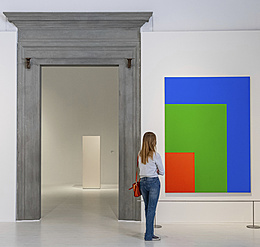CIE system

In the CIE standard colorimetric system, body colours and light colours are represented in a continuous, two-dimensional diagram. The spectral constitution of light colours results from the type of light, while that of body colours results from the type of light and the spectral reflectance or transmittance. The dimension of brightness is left unconsidered here; this means that only the hue and saturation of all colours can be determined in the diagram. The coloured area is enclosed by a curve on which the chromaticity locations of the completely saturated spectral colours lie. At the centre of the area is the point of least saturation, which is designated as a white or uncoloured point. All levels of saturation of one colour can now be found on the straight lines between the uncoloured point and the chromaticity location in question. Similarly, all mixtures of two colours are likewise to be found on a straight line between the two chromaticity locations in question. Complementary colours are located opposite each other in the CIE model and combine to form white.







